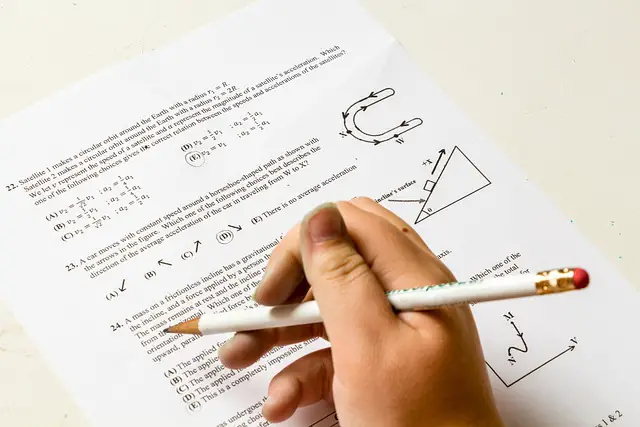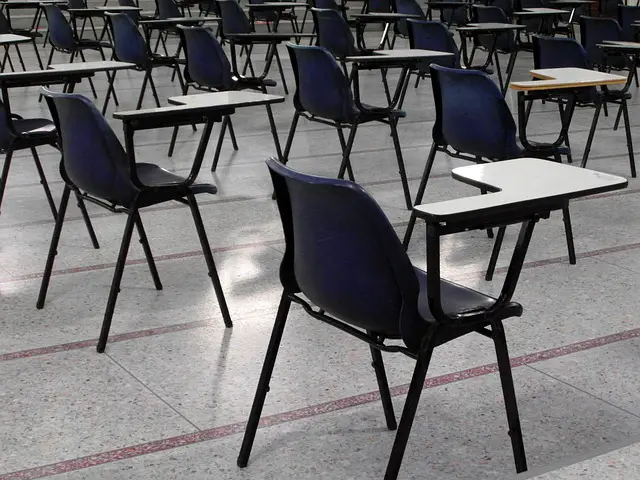Formative assessment guides ongoing learning and provides feedback, while summative assessment evaluates final performance and learning outcomes.
Formative Assessment Vs. Summative Assessment
The key differences between formative and summative assessment lie in their timing, focus, purpose, feedback, and grading approach.
While formative assessment is used during the learning process to monitor progress and provide immediate feedback, summative assessment is utilized to evaluate the overall achievement and assign grades.
Both approaches offer various benefits, and the choice of when to use each depends on the instructional goals and context.
What is Formative Assessment?

Formative assessment is the key to unlocking student growth and understanding! It is all about constant feedback, actionable insights, and tailored instruction.
Through formative assessment, teachers gather information about students’ learning progress throughout a lesson, unit, or course. It aims to provide continuous feedback to both students and teachers, enabling them to adjust instruction and learning strategies accordingly.
Definition of Formative Assessment
Formative assessment, as defined, is the process of gathering information and feedback about students’ learning progress during instruction. It is an ongoing and continuous assessment that helps teachers make instructional decisions and provides students with timely feedback to improve their learning.
The definition of formative assessment aims to assess students’ understanding of the concepts being taught and identifies any misconceptions or gaps in their knowledge. It focuses on the process of learning rather than the final outcome.
In the context of education, the definition of formative assessment refers to any assessment activity that helps teachers and students monitor learning progress and make adjustments as needed. This can include quizzes, class discussions, observations, and group work.
The purpose of formative assessment, as per the definition, is to provide immediate and actionable feedback to both teachers and students. It helps teachers identify areas where students may need additional support and adjust their instruction accordingly. For students, formative assessment allows them to track their own progress, reflect on their learning, and make improvements.
By implementing formative assessments regularly in the classroom, teachers can effectively guide instruction and support student learning. It promotes a student-centered approach by actively involving students in their own learning process and fostering a growth mindset.
Purpose of Formative Assessment
The purpose of formative assessment is to gather information on student learning and understanding throughout the learning process. It aims to provide feedback to both students and teachers, enabling them to modify their teaching and learning strategies accordingly.
Formative assessment helps teachers identify areas where students may be struggling or need additional support. By regularly assessing student progress, teachers can tailor their instruction to meet the specific needs of each student. This promotes student engagement and motivation as they witness their progress and grasp their areas of improvement.
The main objective of formative assessment is not to assign grades or evaluate student performance, but rather to enrich learning and inform instruction. It offers ongoing feedback that guides instructional decisions, encourages student reflection and self-assessment, and fosters a growth mindset.
Some examples of formative assessment include quizzes, class discussions, exit tickets, observations, and one-on-one conferences. These strategies provide valuable insights into student understanding, enabling teachers to make immediate adjustments to their teaching and address misconceptions or gaps in knowledge.
Examples of Formative Assessment
Formative assessments are valuable tools that allow teachers to gather information about students’ learning progress and understanding while instruction is ongoing. They are used to provide feedback to both students and teachers, helping to identify areas where additional support or instruction may be needed. Here are some examples of formative assessments:
| Examples of Formative Assessment 1. Exit Tickets: | Students answer a few questions or complete a short task at the end of a lesson to demonstrate their understanding. |
| Examples of Formative Assessment 2. Observations: | Teachers observe students while they are working on an activity or participating in a discussion to assess their understanding and skills. |
| Examples of Formative Assessment 3. Quizzes or Tests: | Short quizzes or tests can be given to assess students’ comprehension of specific topics or concepts. |
| Examples of Formative Assessment 4. Think-Pair-Share: | Students think about a question or prompt, discuss their ideas with a partner, and then share their thoughts with the whole class. |
| Examples of Formative Assessment 5. Class Discussions: | Engaging students in classroom discussions can provide insight into their understanding and allow for clarification of misconceptions. |
These examples provide teachers with ongoing information about students’ progress, allowing them to adjust instruction and provide timely feedback. By incorporating a variety of formative assessments, teachers can gain a comprehensive understanding of their students’ learning needs.Fact: Research has shown that regular use of formative assessments can lead to improved student achievement and a deeper understanding of the content.”
What is Summative Assessment?

Summative assessment primarily evaluates students’ learning outcomes at the end of a lesson, unit, or course. It focuses on measuring the level of achievement or mastery of specific learning objectives or standards.
Definition of Summative Assessment
Summative assessment, also known as a final evaluation, is a method of assessing students’ learning achievement at the end of a designated period, such as a unit, semester, or academic year. Its main goal is to measure the overall mastery of learning objectives. Unlike formative assessment, which provides continuous feedback to enhance learning, summative assessment aims to assign grades or scores that reflect the students’ level of proficiency. This type of assessment is commonly used to make decisions about promotion, graduation, or to evaluate the effectiveness of a curriculum or instruction.
Some examples of summative assessment include final exams, standardized tests, term papers, projects, and end-of-year evaluations. These assessments are often structured and comprehensive, covering a wide range of content, and requiring students to demonstrate their understanding and application of knowledge.
When utilizing summative assessment, it is crucial to ensure that the assessment aligns with the learning objectives and provides a fair and valid representation of students’ abilities. To accomplish this, clear criteria and rubrics should be employed to provide transparent grading and feedback to students.
To enhance the effectiveness of summative assessment, teachers can consider offering students opportunities for self-reflection and self-assessment. Additionally, providing timely and constructive feedback can aid students in identifying their strengths and areas that require improvement. By incorporating these strategies, summative assessment can become a valuable tool for promoting student growth and success.
Purpose of Summative Assessment
The purpose of summative assessment is to measure a student’s learning and achievement at the end of a learning period or course. It aims to provide an overall evaluation of the student’s knowledge and skills in relation to predetermined standards or learning objectives.
Summative assessment serves as a final judgment of the student’s performance and is usually used for grading and making decisions about promotion or graduation. It provides a comprehensive and conclusive view of what the student has learned throughout the learning process.
The primary purpose of summative assessment is to determine the effectiveness of the instruction and curriculum. It helps educators and institutions evaluate the overall success of their teaching methods and the extent to which students have met the desired learning outcomes.
The purpose of summative assessment is also to provide accountability and transparency. It allows for external stakeholders, such as parents, administrators, and policymakers, to assess the quality of education provided.
Unlike formative assessment, which is ongoing and used to provide feedback during the learning process, the purpose of summative assessment is to make judgments and decisions about students’ overall achievement. It is important to note that both summative and formative assessments are essential components of a comprehensive assessment system, each serving different purposes in the learning and evaluation process.
Examples of Summative Assessment
- A final exam at the end of a semester or academic year to assess a student’s overall knowledge and understanding of the course material.
- A standardized test administered to measure the knowledge and skills of students at a particular grade level, such as a state assessment or national exam.
- A project or research paper that is graded based on specific criteria and serves as a comprehensive assessment of a student’s ability to apply knowledge and demonstrate critical thinking.
- A performance-based assessment, such as a musical recital or a science fair presentation, where students showcase their skills and abilities in a particular area.
- A portfolio assessment, where students compile a collection of their work over a period of time to demonstrate their learning and growth.
- A capstone project or thesis at the end of a degree program, where students demonstrate their mastery of the subject matter through an in-depth research project.
- A licensing or certification exam, such as the Bar Exam for aspiring lawyers or the Medical Board Exam for aspiring doctors, which assesses a candidate’s knowledge and competency in their field.
- A final presentation or defense of a research or creative project, where students present their findings and answer questions from a panel of experts.
Key Differences Between Formative and Summative Assessment
Discover the essential disparities between formative and summative assessment, shedding light on the timing, focus, purpose, feedback, and grading of each approach. Unveiling these nuances will empower you to grasp how these evaluation methods diverge in their roles and impacts on learning outcomes. So, let’s dive in and unravel the distinctive features of formative and summative assessment, helping you navigate the complexities of educational assessment strategies.
Timing
In the context of formative and summative assessment, timing refers to when these assessments are conducted. Formative assessments are typically conducted during the learning process to provide feedback and monitor progress. On the other hand, summative assessments are conducted at the end of a learning period to evaluate students’ overall understanding and achievement.
To illustrate the timing difference between formative and summative assessments, the following table provides a comparison:
| Timing | Formative Assessment | Summative Assessment |
| When | Ongoing and frequent throughout the learning process. | At the end of a unit, course, or academic period. |
| Purpose | To gather real-time feedback on students’ understanding and progress. | To evaluate students’ overall knowledge and competence. |
| Examples | Class discussions, quizzes, homework assignments, and peer evaluations. | Final exams, end-of-course projects, and standardized tests. |
Now, let me share a true story related to the timing of assessments.
In a middle school science class, the teacher utilized formative assessments throughout the unit on human anatomy. After each lesson, the students were given short quizzes to gauge their understanding of the topics covered. The immediate feedback from these formative assessments allowed the teacher to identify areas where students needed additional support.
As a result, the teacher was able to adjust their teaching strategies and provide targeted interventions to help students grasp the concepts better. At the end of the unit, a summative assessment in the form of a comprehensive test was conducted to evaluate the students’ overall understanding.
This combination of timely formative assessments and a final summative assessment helped the teacher track progress and ensure that all students had a solid understanding of human anatomy.
Focus
- Focus is a crucial aspect of formative and summative assessment.
- Formative assessment focuses on providing ongoing feedback and monitoring student progress throughout the learning process.
- Teachers use formative assessment to identify student strengths and weaknesses and make necessary instructional adjustments.
- Examples of formative assessment focus on assessing understanding in real-time, such as classroom discussions, quizzes, and observations.
- Summative assessment, on the other hand, focuses on evaluating student learning and achievement at the end of a unit, course, or program.
- Teachers use summative assessment to assign grades or determine student readiness for the next level of learning.
- Examples of summative assessment include final exams, standardized tests, projects, and essays.
- The primary focus of formative assessment is on improving learning through feedback and guidance, while the main focus of summative assessment is on evaluating student performance.
- Formative assessment is typically low-stakes and aims to cultivate students’ proficiency in a subject.
- On the other hand, summative assessment is high-stakes and focuses on measuring students’ overall achievement and proficiency.
Purpose
Formative assessment and summative assessment serve different purposes in the field of education. The purpose of formative assessment is to provide ongoing feedback and monitor student learning progress during the instructional process. Its primary purpose is to identify students’ strengths and weaknesses, guide instructional decisions, and help students improve their understanding and performance. Examples of formative assessments include quizzes, class discussions, and observations.
On the other hand, the purpose of summative assessment is to evaluate student learning at the end of a unit, course, or educational period. Its purpose is to determine the level of mastery or achievement of learning outcomes and assign grades or marks. Examples of summative assessments include final exams, standardized tests, and projects.
The key difference between formative and summative assessment lies in their timing, focus, and purpose. Formative assessments are carried out throughout the learning process, while summative assessments are conducted at the end. Formative assessments focus on providing feedback and guiding instruction, while summative assessments focus on measuring overall achievement. While formative assessments are used formatively to improve learning, summative assessments are used summatively to evaluate learning.
Understanding the purpose of formative and summative assessment is crucial in designing effective assessment strategies and supporting student learning. By utilizing both types of assessments, educators can gain a comprehensive understanding of students’ progress and ensure that their instructional practices meet the diverse needs of learners.
Feedback
is an essential component of both formative and summative assessment. It provides valuable information to students and teachers about their progress and understanding of the subject matter. In formative assessment, feedback is used to inform instruction and guide students towards improvement. It can be immediate and specific, highlighting areas of strength and areas that need further development. For example, a teacher may provide feedback on a draft of a student’s essay, pointing out areas that need clarification or improvement.
In summative assessment, feedback is typically given after the completion of an assessment task or assignment. It helps students understand how well they have achieved the learning goals and objectives. This feedback can take the form of a grade or a written comment, providing students with information on their performance. For example, a teacher may provide feedback on a final exam, providing a breakdown of scores and areas of strengths and weaknesses.
Feedback in both formative and summative assessment plays a crucial role in motivating students, boosting their confidence, and helping them understand how to improve. It encourages students to reflect on their learning and take ownership of their progress. Teachers, on the other hand, use feedback to evaluate their teaching strategies and make necessary adjustments to meet the needs of their students.
By providing timely and constructive feedback, educators can foster a culture of continuous improvement and support student growth. It cultivates a positive learning environment and enhances students’ overall proficiency and well-being.
True story: In the early 20th century, a young artist named Pablo Picasso received feedback on one of his paintings from a renowned art critic. The critic dismissed Picasso’s work, calling it amateurish and lacking in skill. Instead of being discouraged, Picasso used this feedback to fuel his determination to defy conventional artistic norms. He continued to experiment and develop his unique style, eventually becoming one of the most influential artists of the 20th century. This demonstrates the transformative power of feedback and how it can shape an individual’s growth and success.
Grading
is an essential component of both formative and summative assessments. It allows teachers to evaluate student performance and provide feedback on their progress. When it comes to grading, it is important to consider the following factors:
Grading should be based on clear criteria that align with the learning objectives of the assessment. This ensures consistency and fairness in evaluating student work.
Grading should be done using a variety of assessment methods to obtain a comprehensive and accurate picture of student performance. This can include quizzes, tests, projects, presentations, and class participation.
Grading should provide specific and constructive feedback to students, highlighting their strengths and areas for improvement. This feedback is crucial in helping students understand their progress and make necessary adjustments to enhance their learning.
Grading should be transparent and communicated to students in a timely manner. It is important for students to know how they are being assessed and what their grades reflect.
Grading is an integral part of the assessment process. It helps teachers evaluate student performance, provide feedback, and guide instructional decisions. By ensuring clear criteria, using a variety of assessment methods, providing constructive feedback, and maintaining transparency, grading can effectively support student learning.
When to Use Formative and Summative Assessment?
Whether you’re an educator or a student, understanding when to use formative and summative assessment can greatly impact learning outcomes. In this section, we’ll uncover the practicality and advantages of each approach. Discover the benefits of formative assessment in enhancing real-time feedback and encouraging student growth. We’ll explore the advantages of summative assessment in evaluating overall proficiency and measuring academic achievement. Get ready to navigate the dynamic landscape of assessment strategies for optimal educational success.
Benefits of Formative Assessment
The benefits of formative assessment, also known as the benefits of Formative Assessment, include:
- Improved learning: Formative assessment provides ongoing feedback to students, allowing them to identify their strengths and areas for improvement. This feedback can help guide their learning and help them make necessary adjustments along the way.
- Targeted instruction: By regularly assessing student understanding and progress, teachers can quickly identify areas where students may be struggling and tailor their instruction accordingly. This helps ensure that students receive the support and resources they need to succeed.
- Enhanced engagement: Formative assessment often involves active participation from students, such as through discussions, group work, or self-assessment. This helps to keep students engaged and motivated, as they are actively involved in their own learning process.
- Personalized feedback: Teachers can provide individualized feedback to students based on their specific strengths and weaknesses. This feedback helps students understand where they stand and what steps they can take to improve.
- Self-reflection: Formative assessment encourages students to reflect on their own learning and progress. This self-reflection helps students develop metacognitive skills, enabling them to become more independent and self-directed learners.
- Identification of instructional gaps: Formative assessment allows teachers to identify any gaps in their teaching strategies or curriculum. By collecting data on student understanding, teachers can make informed decisions about instructional adjustments or additional support that may be needed.
- Building a positive classroom culture: Regular formative assessment can foster a positive classroom culture, as it creates an environment where students feel comfortable taking risks, making mistakes, and seeking help when needed. It promotes a growth mindset and a focus on continuous improvement.
Benefits of Summative Assessment
- Clear evaluation of student performance: Summative assessment provides a comprehensive evaluation of a student’s understanding and mastery of a subject or topic. It allows teachers to assess the overall knowledge and skills acquired by the students throughout a specific period.
- Identifies learning gaps: By assessing students’ performance at the end of a unit or term, summative assessment helps identify any gaps in learning and areas where students may need additional support or intervention.
- Feedback for future improvement: Summative assessment provides feedback that can be utilized by students to improve their future performances. It helps students understand their strengths and weaknesses, enabling them to focus on areas of improvement.
- Evidence of achievement: Summative assessment provides tangible evidence of achievement for students, parents, and educational institutions. It serves as a record or documentation of what a student has learned and their level of competency.
- Comparison and standardization: Summative assessments allow for comparison and standardization across different students and educational institutions. It helps establish benchmarks and standards for grading and evaluating student performance.
Interestingly, research has shown that a combination of formative and summative assessment leads to better learning outcomes for students. By incorporating both types of assessment, teachers can provide continuous feedback, identify learning gaps, and ensure students’ overall progress.
Frequently Asked Questions
What is the difference between formative and summative assessments?
Formative assessments are used to monitor and evaluate students’ progress during their learning, providing ongoing feedback to improve teaching and learning. Summative assessments, on the other hand, are used to evaluate student learning at the end of an instructional unit by comparing it against a standard or benchmark.
What are some examples of formative assessments?
Formative assessments can take various forms, such as quizzes, class games, on-the-spot evaluations, teacher observation, and exit tickets. These assessments provide teachers with feedback in real-time and help personalize instruction based on students’ needs.
What are some examples of summative assessments?
Summative assessments measure how much a student has learned and mastered over a period of study. Examples of summative assessments include state tests, final exams, reports, presentations, and projects that demonstrate cumulative knowledge acquired throughout the instructional unit.
How are formative assessments different from summative assessments in terms of purpose?
The purpose of formative assessments is to monitor and improve learning, providing ongoing feedback and allowing teachers to address problems immediately. Summative assessments, on the other hand, are focused on evaluating learning at the end of a unit and determine if students have achieved the expected learning outcomes.
What are the stakes involved in formative and summative assessments?
Formative assessments are low stakes, meaning they carry lesser consequences for students, and are primarily aimed at providing feedback. Summative assessments, on the other hand, are often high stakes as they compare student performance against a standard and determine overall achievement levels.
How do formative and summative assessments contribute to improving teaching and learning?
Formative assessments help students identify their strengths and weaknesses and allow faculty to address problems immediately, leading to continuous improvements in teaching and learning. Summative assessments provide comprehensive evaluations of student learning, which can be used formatively to guide efforts and activities in subsequent courses, ensuring academic outcomes are enhanced.
Image Credits
Featured Image By – Shekinyashi, mussa, CC BY-SA 4.0 <https://creativecommons.org/licenses/by-sa/4.0>, via Wikimedia Commons
Image 1 By – tjevans from Pixabay
Image 2 By – PublicDomainPictures from Pixabay









